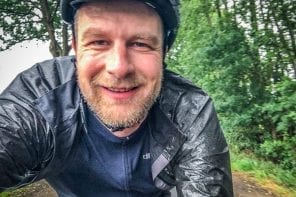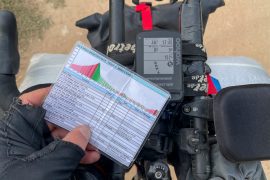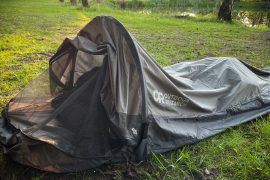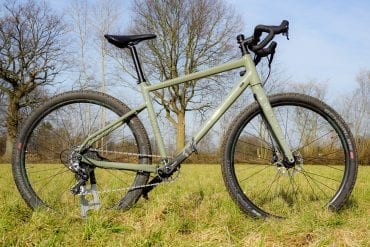Only a few more days and then I’ll once again be at the start of a bikepacking ultra race: this time it’s the Trans Balkan Race, which runs 1,380 km through Slovenia, Croatia, Bosnia-Herzegovina and Montenegro and starts on 31 May in Sežana, Slovenia.
And I’m really looking forward to it, because it’s not “just” another race, but will take me through four countries that are new and unknown to me, as well as through nine national parks and thus through a beautiful and impressive landscape.
After last year’s Bohemian Border Bash Race, I’ve adopted a different strategy for this year: enjoy the scenery and the ride more, ride less empty, take more care of myself.
And I’m sure I’ll do pretty well with that. I originally planned 6 days for the route. But I don’t know the area or all the challenges of the route and the expected weather. In total, I have until the 8th of June (I’m travelling back on the morning of the 9th). That means I have a maximum of 9 days at my disposal. That should be enough, even if something comes up.
The Trans Balkan Race is still relatively young. The race was held for the first time in 2022 and I’ve wanted to ride it ever since. A total of 27,000 metres of altitude difference have to be overcome over the 1,380 km. And a glance at the route profile shows that this will be no mean feat. On the contrary: it will be steep and challenging. And that’s a good thing.
And as is so often the case, the best is saved for last: on the last 340 kilometres, you not only cross the border from Bosnia-Herzegovina to Montenegro, but also have to climb 6,700 metres in altitude.

From the profile, it looks like an eternal up and down – a good test of character after you’ve already covered 1,000 kilometres and over 20,000 metres of altitude. I have a lot of respect, but I also really want to do it. Hopefully the weather will be fine, because it goes up to over 1,900 metres.
Bikepacking race categories
In preparation, I like to look at the ratio of altitude metres to 100 km. This gives you a good idea of what you’re up against. And it gives you an approximate comparison with other bikepacking races.
The Trans Balkan Race has a ratio of around 2,000 metres of elevation gain per 100 km (1,956 m to be precise). This means that on paper it has more vertical metres than the Bohemian Border Bash Race with 1,846 vertical metres per 100 km, but should be comparable in terms of the route requirements.
The Atlas Mountain Race has just under 1,700 metres of climbing per 100 km, while the Silk Road Mountain Race has 1,600 metres of climbing per 100 km.
Of course, the level of difficulty also depends on the nature of the route, the climate, the weather, the altitude and the time available.
On the BBBR, for example, you only have 8 days in total. The TBR gives you 10 days. The AMR gives you 9 days.
So that you can get an idea and perhaps also better classify one or the other race, I have rated 20 bikepacking races (subjectively selected) in terms of the altitude metres per 100 km ratio and how they differ in length and altitude metres.

You can basically see 3 categories: reasonably moderate races (in green) with up to 1,700 metres of climbing per 100 km. Then races with metres of climbing per 100 km from 1,800 to 2,300 (in blue). Here it really gets down to business. And then the real ultra races under the altitude metres, with 3,000 to more than 3,500 metres of climbing per 100 km (in orange).

For your information: I have removed the Tour Divide here with its 4,400km and over 60,000 metres of climbing, as it would otherwise distort the graphic.
During the Bohemian Border Bash Race I rode around 5,000 metres of climbing over 200 km per day and during the Orbit with Stephan 3,000 metres of climbing over 100 km. Both were challenging. But with this experience, I also categorise this data for myself.
According to Komoot, the Trans Balkan Race has a good mix of all surfaces:
- Natural surface: 81.5 km
- Loose surface: 322 km
- Gravel: 328 km
- Paved road: 188 km
- Tarmac: 435 km
How this will look in reality remains to be seen. But I assume that there will be a few opportunities to recover on tarmac.
However, you should pay particular attention to the minefields, which are clearly indicated in the road book. A distinction is made here between “Warning of mines” and “High Danger”. You should avoid travelling through at night (although this will not always be possible) and in any case you should stay on the track and not bivouac or take a break off the trail.
Preparation
Since the Atlas Mountain Race 2020, I have been training regularly and in a structured way 5-6 times a week and therefore have a very good basic level of fitness to compete in such races and not only to survive, but also to have fun. In the last few days before the race, I will only do a few short interval sessions and give my body a rest.
This time I’ve put a bit more energy into my mental preparation because, as described above, I don’t want to repeat the mistakes I made in Bohemia and then have to give up physically exhausted and with a sore bum just before the finish.
In order to familiarise myself intensively with the route and prepare myself, I also made a road book again. I printed out the supply points and information about the mine areas.
I use the Komoot app to check the next sections of the route on the go and I’ve also transferred the tracks to Google Maps and created documentation there with supply points and possible accommodation. I can then always check where I am and what lies ahead of me while I’m out and about.

I also hope to be able to keep an eye on the weather via my smartphone. In any case, I’ll be using the “Epic Ride Weather” app again, which indicates the expected weather based on the track.
Bike & equipment
I have built myself a hardtail MTB for the Trans Balkan Race. You can find all the details here. You may have already realised that MTBs are often the better choice for races of this kind. In any case, it is a bit more comfortable off-road and I have a lot of space and storage capacity thanks to the large frame triangle. I’ll be using this to take plenty of food with me on the road.

The frame also offers the option of carrying bottles on the saddle rails. This leaves my fork free at the front and I feel more comfortable with it. In addition to the bottles, I also take a hydration pack with a 1.5 litre hydration bladder.
For the pack options, I initially planned to use a Tailfin Aeropack so that my front remained free. But that didn’t really work out, mainly because there is no axle for the Nordest to which the AeroPack can be clamped. >>> Yes, there is the universal axle you can use for. However, you can screw the Tailfin to the corresponding eyelets.

But that seemed too unsafe to me, also because I assume that the load on the screw connection to the frame would be very high off-road and could possibly damage the Tailfin struts. Even if it’s not likely, I wanted to avoid the risk and switched back to the tried and tested system that I’ve used in other races: handlebar rollers and saddle bag.
This time, however, the long Cyclite top tube bag is new. I modified it slightly and added holes for the eyelets. I also swapped the strap at the end of the bag for a rubber Tailfin strap. This keeps the bag even more stable.

In the top tube bag I carry food and my multitool at the front. At the back, a spare battery for the gears, a power bank with cables and tissues.
The full frame bag is from 7 Roads in the Ukraine and I had this two-part bag sewn especially for the Nordest. It offers a lot of space and is not fully packed. It gives me plenty of spare space to store enough food and drink on the way and to cover longer distances without resupply.

The top section of the bag contains gels and bars, a small rucksack, my head torch, waistcoat, water filter, small knife and small multi-tool (pliers) and the second power bank with charging head and documents as well as my wallet. In the lower bag is chain wax, sealant, two emergency inner tubes, a light bike lock and the pharmacy.
As always, the tools and spare brake pads are in the box on the down tube.

At the front of the handlebars in the Revelate Designs Pronghorn is my sleeping kit with sleeping bag (Cumulus X-Lite 200), sleeping mat (TAR Uberlite), spare bib, wash kit and down jacket. I also have two Revelate food pouches on the handlebars. I don’t know yet whether both will end up going into the race.

At the back is the Restrap Race saddle bag. Like the Pronghorn, this harness system is very light at the front. In the saddle bag I carry the OR Helium bivy sack, gloves, short rain trousers, gaiters and leg warmers. There’s still room left here too.

All in all, everything is packed very loosely and, as already mentioned, still offers storage space for travelling. I weighed in at 19.5-20kg without water and including bike and 1kg gels & bars.
You can follow the race here
Of course there is dotwatching again and you can follow the race on MapProgress: https://transbalkanrace2024.maprogress.com/
I (probably) have cap number 31 and you can find my dot under this link: https://transbalkanrace2024.maprogress.com/?n=31

Current info from the road
For a few years now, I’ve also set up a WhatsApp group where I post blog and podcast updates. In this group, I also post a few impressions and information from the road.
You can join the group via this link (and leave it just as easily).
I’ll also be posting on Instagram from time to time. You can find me here under @biketourglobal.
It’s also worth following the hashtags #TBR2024 and #transbalkanrace to see other people’s updates.
Then keep your fingers crossed that my journey works out. Deutsche Bahn let me down again, so I had to change my plans at short notice. But it’ll be fine…






